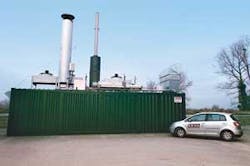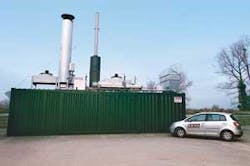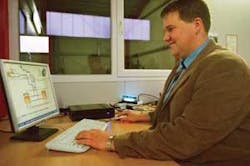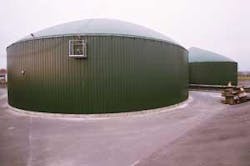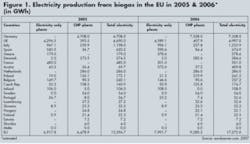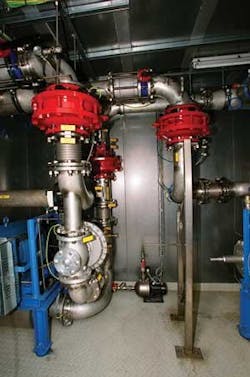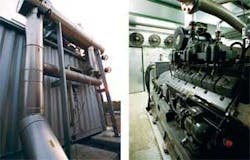Biogas Energy to Reckon with…
By Marc Schaller
CIAT, SEVA & Siloxa unite for “green” energy solutions by making biogas recovery a practical reality in Germany and abroad.
Biogas is a “green” energy offering utilities and industry a way to cut their carbon footprint and energy costs simultaneously. The produced kilowatt cost isn’t yet a competitor against nuclear or fossil fuel energies, but the systems installed are more and more efficient – and their financial profitability is rising rapidly.
In this field, Germany is now the No.1 biogas-based energy producer as well as technological leader globally. It built 820 systems in 2006, increasing its total installed production units to 3,700. French company CIAT plays a major role in this, gaining a 35% share of the German market, acquiring expertise in gas treatment and enabling it to propose systems adapted to wider scopes of application. This forward-looking concept has brought about specific developments in the field. Two installations produced with German partners of CIAT, SEVA Energie AG and Siloxa Engineering AG, illustrate such progress.
European biogas electricity production in 2006 was 17,272 GWh per year in 2006, led by Germany with 7,338 GWh alone and followed by the UK, Italy, Spain, Greece, France and Austria. Biogas now represents 1.2% of annual electricity production and nearly 10% of renewable energy, with an installed power nearing 1,500 MW. This success is due to regulations intended to promote renewable energies.
For 20 years, German law stipulates the purchase price per kWh by energy distributing companies – taking into account the “green” nature of the energy and recompensing operators based on efficiency, technological innovation and agricultural re-conversion criteria. During the first year, in certain cases this may reach €0.18/kWh. That incentive, combined with German industry, makes the country the most advanced worldwide in biogas-based energy production systems.
Several types of biogas production systems exist, but always involve producing electricity using a gas engine and an alternator. Process heat also can be recovered. This is called cogeneration. Biogas is a gas produced by fermentation of animal or vegetable organic matter without oxygen. Fermentation, also called methanization, occurs naturally (in swamps) or spontaneously in waste dumps containing organic waste. Also, it can be artificially produced in digesters (when treating sewage sludge, industrial organic waste or selected agricultural crops, etc.). Biogas can also be recovered by sucking mine gas. In all cases, the biogas must be dehumidified and purified before combustion – otherwise, it can damage the gas engine.
Biogas is a mixture essentially comprising methane (30-70%) and carbon dioxide (CO2), with varying quantities of water and hydrogen sulfide (H2S). Other compounds can also be found from contamination, especially in waste dump biogas: ammonia, hydrogen, nitrogen and carbon monoxide. Biogas energy is only produced from methane and is in fact a renewable form of fossil energy, which is natural gas. Moreover, biogas systems are highly respectful of the environment, as the contribution of a methane molecule (CH4) to the greenhouse effect is 21 times greater than a carbon dioxide molecule. Thus burning methane, even though producing CO2, reduces its environmental impact.
Systems Already Profitable
SEVA Energie, of Emstek, Germany, has jumped to the forefront of know-how for small systems. Out of the 820 Germany installed in 2006, this company, with a staff of 150, produced 170 biogas combustion units, generating a cumulative 54 MW of power. The philosophy at SEVA is to make biogas profitable by offering high production rate systems that operate continuously with limited human intervention and very high reliability.
CIAT technology has become a recognized standard for the up-line treatment part of gas production. Here, again, humidity is removed from the gas. Steam is condensed by cooling this gas to 5-15°C. The advantage of this process is to eliminate a portion of gas impurities by trapping them in the condensates, which are evacuated. This protects the motor, reducing maintenance frequency and prolonging service life. The operation is carried out by an optimized CIAT refrigeration unit and heat exchanger set, delivering specified cooling needs.
“What we like at CIAT is it is always capable of reactively responding with the precise technical solution”, explains SEVA project leader Klaus Vieth. Reliability is also a strong point: “We tried several competitors’ systems previously, but found too many failures, especially in the refrigeration unit, which is located outside”.
Adds Michael Siemer, SEVA sales manager: “For each new development project, we forward our specifications to CIAT, who help us size the components to integrate in the best possible manner. They respond quickly, the prices are competitive and there is always a CIAT product corresponding to our need”.
The Mönninghausen GmbH Biogas system in Geseke, Germany, illustrates SEVA’s capacity to provide profitable solutions. The gas here is produced by fermentation of organic waste, delivered by truck weekly. The installed electrical power is 537 kW for a 230 Nm3/h biogas flow rate. The system duty factor is 97%, being 8,500 hours per year. This system only requires a technician’s presence for two hours a day. The control system designed by SEVA displays instantaneous operating parameters from its office in EMSTEK and sends telephone or small message service (SMS) alerts in case of an operating incident. Shutdowns are thus minimized. The cost per kWh produced is €0.08. Today, the energy is sold at €0.16. “As a general rule, our customers obtain an investment return in two to four years”, concluded Siemer.
Furthermore, this system consumes 70% of the produced heat (sterilization of organic waste before methanization, maintaining methanizers at operating temperature, heating of neighbouring buildings and neighbouring chicken farms) which participates in the investment profitability. About 15% of the biogas energy yield was obtained by heat recovery in Germany in 2006 – equivalent to 1,324 kilotone equivalent petrol (KTEP)/year. SEVA is present internationally in Europe, the USA, Thailand and Japan.
Cutting Edge Gas Treatment
Siloxa, of Essen, Germany, specializes in biogas treatment, i.e., industrial or agricultural biogas, waste gas, station epuration (STEP) or mines. Founded in 1998, it differentiates itself from other companies by offering a range of biogas impurity treatment solutions. Biogas saturated in steam contains impurities such as organic silica compounds (siloxanes) and H2S. These compounds’ presence is highly detrimental to gas engine reliability. Other than corrosion generated by H2S, irreversible damage may be caused by siloxane, which is deposited in combustion chambers and can cause total engine shutdown. Steam creates condensation in the pipeline system, which also causes corrosion, alteration to valve and measurement instrument calibration, and pressure variations.
The differentiating characteristic of the system installed by Siloxa at Recklinghausen, Germany, (4/5 König Ludwig mine shaft) is its high capacity: 2,400 Nm3/h for annual electricity production of 20 GWh – the equivalent of six large wind turbines. The centre container, fitted with two compressors, sucks up underground gas at a 400 meter depth through a shaft. The gas is dehumidified through an exchanger powered by a rooftop refrigeration unit and distributed to four motors in the adjacent cogeneration containers. Once again, profitability and reliability are key elements – with continuous process, maximum availability, minimum human intervention (1 hour/day) since commissioning. Modules are fully transportable so, when the mine no longer produces sufficient methane, the entire energy production system can be moved to another mine.
Jochen Beese, a Siloxa boardmember, explains why CIAT was chosen: “Our systems range from 100 m3/h to 4,000 m3/h. CIAT provides us with extensive experience in choosing solutions and sizing systems. Furthermore, the characteristics of the CIAT equipment are exceptional in terms of energy yield”.
The company, employing 22 people, also offers a range of solutions for gas extraction and transport over long distances.
Taking the Heat in Cogeneration
Marc Schaller, CIAT’s industrial segment marketing manager, explains that its work in Germany “enabled us to work alongside the players in this sector. Our experience in the sector and our equipment range allows us to propose a system solution sized ideally over the entire power range. And, with our mastery in three technologies, we can propose the five main heat exchangers of a cogeneration system”.
Targeting applications in production, distribution or transformation of energy, air or water, the company provides equipment and expertise, based on the three main skills of thermal exchange: air conditioning and hot or cold production from thermodynamic cycles. Its tubular exchangers also benefit from structural exchange surfaces to maximize heat transfer.
“Biogas is considered as one of the cleanest green energies and its use will naturally progress across the world. We already have numerous projects or installations completed in Russia, Thailand, England, France, Spain and Turkey, and this is just the beginning. Others are copying the German model, offering financial incentives that are sometimes greater”, Schaller added.
Conclusion
Technological progress in the last year has made biogas a more competitive solution to rising energy costs. Even if it never replaces nuclear or fossil fuel energies, biogas will be a leading “green” solutions in coming decades as Europe and the world come to grips with climate change and sustainable ways to slow its impact.
While Germany leads the market, biogas projects have emerged in other European countries as well. In Germany, utilities are compelled to buy kWh at €0.16. In the UK, Italy or Spain, regulations are more helpful for who decides to operate a biogas plant (€0.32/kWh in Italy!).
Still, with operational costs as low as €0.08/kWh, the German experience (and the one of CIAT) remains competitive.
Author’s Note:
Marc Schaller is marketing manager for the industrial segment of CIAT, a specialist in air conditioning, air-handling, heat exchange and heating using renewable energy that’s based in Culoz, France. Contact: www.ciat.com
